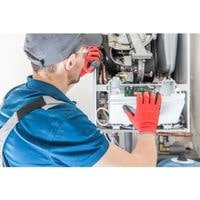Bryant Furnace is not heating. If you’re looking for help fixing your furnace, look no further.
Our reliable Bryant Furnace Troubleshooting guide will have common issues explained and provide tips on how to deal with these problems in case they do arise.
Bryant Furnace not heating

Here we will discuss some common issues and solutions for the Bryant Furnace not heating.
Defective Draft Inducer Motor
The draft inducer motor draws air from inside the house and then blows it out through the vent to the outside of your furnace, causing the flue to heat up.
If there’s a pressure switch, it will sense that the pressure has changed and that there is enough air flowing: if not, it will signal to shut off the fireplace until more air flows from inside.
If the pressure switch doesn’t work because of defects in its components, then the furnace won’t be able to ignite correctly, which will cause it to be turned off after several minutes.
Check Control Board
The control board is a nerve center for the furnace. It regulates the power supply to all of the other components. If it fails, it may not send voltage to the ignition system, causing the furnace not to heat up.
The flame rollout limit switch
A flame rollout switch can be tested using a multimeter. The key is to find good ground and attach the negative lead to it first.
The switch won’t work unless the ground side makes contact with the negative side. Once you confirm that some sort of connection has been made,
You should check to see if continuity exists by touching one of the positive leads against each zone in turn that must pass electricity through in order for your furnace to fire up.
Faulty Wall Thermostat
Gas Valve Assembly issue
When the gas valve is closed, no gas can reach the pilot light. This prevents the furnace from keeping its warm temperature.
Test the valve’s continuity using a multimeter to find out whether it is working correctly or if it needs to be replaced. Unscrew and take off your furnace’s top panel, remove your old gas valve and replace it with a new one.
Replace Pressure Switch
When there is sufficient airflow to the burner, the pressure switch closes. In some cases, the pressure switch does not close when proper airflow is present, resulting in stalled ignition.
You can test the pressure switch for continuity with a multimeter to see if it is defective. You should replace it if there is no continuity.
Air Flow Issues
Proper airflow through the burner is necessary for the furnace to continue to work. The air is drawn from outside the building.
The furnace may not be able to heat properly if it is located in a utility closet or a cramped storage room. Look for obstructions at the air intake if the furnace draws air from outside.
Cracked Igniter
An igniter glows bright orange when it gets hot enough to light the gas burner. An igniter that fails or cracks will prevent the furnace from heating.
You can determine if it is faulty by removing the igniter and inspecting it for cracks. It must be replaced if it is cracked.
In case the igniter is not cracked, test its continuity with a multimeter. If the igniter has no continuity, it should be replaced.
Flame Sensor fault
The flame sensor prevents the furnace from providing heat when there isn’t actually a flame to begin with. If this sensor is defective, it’ll prevent the furnace from lighting, and you won’t be able to keep your home warm.
If dirtiness on the part of the flame sensors rather than defects turns out to be the culprit in preventing the furnace from heating, you can easily clean them off with a simple abrasive cleaning pad.
